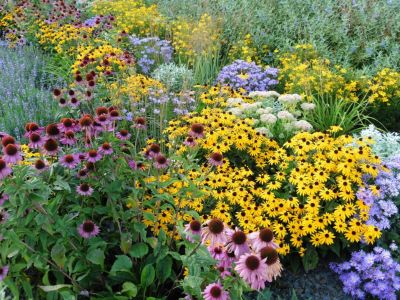Perennial Garden Plants
When trying to decide which little miracles to plant in your perennial garden design, just take a look around you. If you have neighbors who also enjoy gardening, ask them or just observe what perennial garden plants they have grown successfully. Which ones come back year after year and require little or no maintenance? Which ones have been too delicate to survive the winter? If you live in hot and humid climates, be sure to inquire as to which perennials tend to overrun the garden and require constant cutting back and digging up. Even in my cool mountain climate, it’s well known that planting peppermint or spearmint in the garden is asking for trouble; it will quadruple in size year after year and, like some in-laws I know, is nearly impossible to get rid of. There are countless books and catalogs that will also be helpful in your search to find the perfect practical perennial garden plants. If you’re having trouble deciding on perennials to display in your garden, try a local gardening book written especially for your climate zone and weather conditions, or simply determine which zone you’re in and pay attention to the zone indicators in each plant’s description. For instance, in the guide to perennials I’m reading, it shows that dianthus (a happy little pink flower) enjoys zones 3 to 8, full sun, and well-drained dry to moist soil. In my zone 5 dry soil, dianthus should fare just fine.
Soil for Perennial Flower Gardens
Regardless of whether your neighbors and friends are helpful in your search, you will still need to do some digging, literally, of your own. No two gardens are ever alike. Just across the street from me lives a very lucky woman who has light, sandy soil full of organic matter that is quite fertile. At my house, however, my garden contains sticky, dense clay soil that has a tendency to be on the dry, infertile side because of the many evergreens gracing my yard. You can determine your soil’s type by holding some in your hand and moistening it. It will either form a sticky, solid, clay-type ball, a sandy ball that easily falls apart in your hand, or something in between.
How to Design a Perennial Garden
Now that you have an idea of which plants will suit your location’s particular characteristics, the joyful process of preparing, designing, and maintaining the garden bed begins. As part of your perennial garden design process, performing a pH and nutrient soil test is a good first step. It will let you know what nutrients are lacking or if the pH is off balance. A pH range of 6.0 to 7.0 (slightly acidic to neutral) is acceptable to most all perennial flower gardens. Once the soil test has been done and any adjustments have been made, add 1 inch (2.5 cm.) of compost to the top of the soil, making sure the soil is not too wet (soaked) or too dry (dusty), and turn it over with a shovel being careful not to trample it after digging. If this soil preparation can be done the fall before next spring’s planting, it would be ideal. If not, wait at least a day before planting the bed. Plant the perennials on a cloudy and cool day, if possible, to avoid shock. Make sure to give them sufficient space to double or triple in size. As perennial garden plants bloom, remove any spent blossoms by simply pinching them off with your fingers. Each spring it is also a good idea to spread well-rotted manure, compost, or organic fertilizer on the surface of the soil and cover it with a mulch such as chopped leaves or straw to keep the soil moist and fertile. If the plants have become crowded after a few years at their location, dig up the perennial clump, divide it into two or three sections with a knife, being careful not to let the roots dry out, and replant them, either expanding the flower bed or choosing a new location– even giving them to friends. It’s easy to make friends when you have free perennials. Gardening with perennials is fun and easy. These gardens return each year, bringing additional enjoyment with each new bloom.
